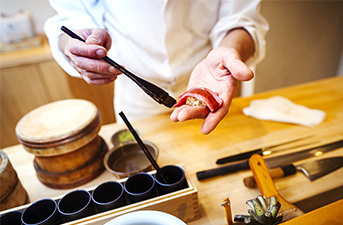Restaurants(9573)
Motsuyaki Captain Yoyogi
Hobo Shinjuku Norengai’s resident motsuyaki specialist, this Yoyogi restaurant takes particular pride in the freshness of the pork offal in their restaurant, to the point where it confidently serves it up sashimi-style.
Sushi Gotoroppo
A traditional Japanese wagashi sweets shop and a premium omakase sushi restaurant rolled into one, Sushi Gotoroppo is at the peak of both culinary art forms. It’s located at the top of 10 flights of stairs, but the rewards are worth it.
Jukusei Sushi Wagokoro
Almost 30 types of sushi are beautifully sculpted and served here at this Shibuya sushi establishment — each one made with fish that has been aged for the optimal amount of time to bring out its natural umami.
Tempura Obata
Since 2017, Tempura Obata has made its mark as a high-quality tempura restaurant with an emphasis on fresh, seasonal ingredients and a calming refined atmosphere.
Nihonbashi Asada (Mitsui Garden Hotel Nihonbashi Premier)
Situated on the ninth floor of the Mitsui Garden Hotel Nihonbashi Premier, this restaurant is a true gem that seamlessly blends traditional Kaga cuisine with modern culinary artistry for a truly unforgettable dining experience.
Gion Kurashita
At his Gion restaurant, Chef Kurashita Satoru expertly prepares traditional Kyoto kaiseki, displaying mastery over all ingredients, from king crab and wagyu beef to even the humble tofu.
Arata Naru Bondz Susukino Honten
A warm atmosphere, friendly tableside service, and 10 different cuts of fresh — not frozen — mutton await visitors to this jingisukan restaurant in Sapporo’s nightlife district of Susukino.
Sushi Takahiro (Shinjuku)
Witness a prodigy at work. After just 13 years of training, Chef Ikuta Takahiro starts his own restaurant in Shinjuku, having joined the industry at just 18 years of age as an apprentice.
Kappo Sushi Hana Aza
Three of Fukuoka’s foremost experts in Japanese cuisine depart for an exciting new culinary adventure in the city’s Akasaka district. Novel kappo and sushi creations draw inspiration from cuisine both within and outside of Japan.
Hakata Nakasu Rokusantei
With over 60 years of history, this Nakasu riverside restaurant serves the deadly poisonous fugu in various forms from hotpot to sashimi, alongside other local Fukuoka delicacies. Expert chefs prepare it at the counter right before guests’ eyes.
Sushi Kunimitsu
With a pedigree from some of the finest restaurants in Japan, America and Germany, Sushi Kunimitsu’s head chef enthralls guests with the combination of impeccable sushi and fluent English.
Akasaka Sushi Matsumoto
The original, formerly Michelin-starred branch of this famed sushi restaurant continues to serve excellent Edomae sushi and traditional small plates in elaborate course menus at its Akasaka location.
Yaesu Sushi Umi
With two Michelin stars for 10 consecutive years. Sushi Umi continues the legacy of greatness with its Yaesu outlet, serving high-class Edomae sushi in omakase course menus directly outside Tokyo Station.
Ginza Yamashina
The head chef and manager at this Ginza yakiniku restaurant purchases an entire cow at a time, choosing each one for the perfect balance of fat and lean meat content — characterized by a deep red “azuki-iro” shade.
Niku-Azabu Ebisu
Niku-Azabu Ebisu draws in a hungry crowd of locals thanks to its winning combination: affordable kuroge wagyu, a quasi-pub ambiance and an impressive array of beers on taps.
Honten Yamashina
Perched on the top floor of Ginza Place, Honten Yamashina's unparalleled teppanyaki features 40-month-old Omi beef from Ozaki Farm in Shiga Prefecture.
Tenjin Kurogeryu Yakiniku Mitsuboshi
The restaurant by Fukuoka’s riverside area calls itself a “meat scientist,” combining the thrill of live yakiniku grilling with high-quality kuroge wagyu beef sourced from all over the Kyushu region.
Onzoushi Kiyoyasutei Roppongi
Roppongi’s rite of passage to everything regal and Japanese is found in this subterranean space, where a stunning courtyard anchors the space and decadent hairy crab and beef gets the aristocratic treatment it deserves.
Yakiniku Bar Tamura
Overlooking the iconic red brick of the Former Hokkaido Government Office Building, quality is king at this premium wagyu yakiniku establishment in Sapporo, evidenced by the fresh cuts of meat.
Ibushigin Kazuya
Choose from an expansive 120 bottle sake collection with varieties from every prefecture of Japan at this Kyoto izakaya in the lively Nakagyo district. Savor each cup of sake alongside an assortment of their specialty smoked dishes.
Capi
Chopped wagyu kneaded into brioche and cauliflower mousse topped with caviar — Michelin-starred chef Ogawa Daiki is ushering in a new era of sophistication in Osaka's creative cuisine scene.
Sushi Sanshin
Owner-chef Yoshitaka Ishibuchi adheres to traditional Edomae techniques and specially-grown rice to craft delectable sushi suiting modern palates, earning Sushi Sanshin one Michelin Star.
Nent
Find respite from Osaka city life at Nent in Umeda. This Michelin-starred French restaurant constantly pushes the boundaries of tradition through delectable dishes and Japanese ingredients.
Oryori Fujii
From the bounty-blessed region of Toyama, traditional Japanese dishes come together at Oryori Fujii, where the owner almost exclusively uses ingredients from his hometown.

Kuramoto Ryori Maruto Shoyu
Time, innovation, and flavor converge in an old soy sauce brewery that’s earned a Michelin Green Star. Kuramoto Ryori Maruto Shoyu is revitalizing taste buds while preserving a slice of Nara's history with every perfect dish.

Hoto Sushi
Conversation flows freely at this six-seat counter, where the chef leads diners on an intimate sushi experience. From meticulous wasabi to hand-crafted soy sauce, each element speaks of dedication and sushi artistry in its purest form.

MAZ Tokyo
Integrating Peru’s rich biodiversity into the creation of every dish, this Michelin-starred restaurant frames its courses on the theme of altitude, taking guests higher and higher on an unforgettable gastronomic journey with every bite.

Trois Visages
Trois Visages lives up to its name – and its one Michelin Star – in its interconnectedness to the “three faces” behind its unique French cuisine: local food producers, the staff, and the guests.
